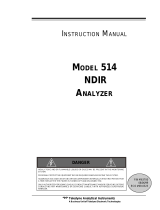Page is loading ...

www.esabna.com
DATE: December 17, 2004 BULLETIN NO: P_04_019
Revised – January 4, 2005
TITLE/ PRODUCT NAME: ESP 200 Calibration Procedure
RATING:
_
_ DIRECTIVE _ _ ALERT
(Action is Required) (Potential Problem)
_
X_ INFORMATION _ _ PRODUCT IMPROVEMENT
(Action is Optional) (Enhanced Product)
_
X_ General Distribution _ _ Business Confidential
(Unrestricted) (Restricted Distribution)
PRODUCT SERIES/ MODEL:
ESP-200 Series A PN-36324 and 36974
SERIAL NO:
All serial numbers
SUMMARY:
This procedure allows for field calibration of the ESP-200 voltmeter and ammeter when the
isolation amplifier PCB is replaced
OPERATIONAL IMPACT:
Improves the accuracy of the voltmeter and ammeter compared to actual cutting conditions
ACTION:
Perform the following procedure when replacing the 38094 Isolation Amplifier Printed Circuit
Board assembly. Perform Section 1 to calibrate the voltmeter. Perform Section 2 if using a
DMM to calibrate the ammeter. Perform section 3 using a clamp on ammeter (preferred
method).

CALIBRATION PROCEDURE
for the
38094 ISOLATION AMPLIFIER
Section 1 - Voltmeter Calibration
A hand held digital voltmeter (FLUKE model 77 or equivalent) capable of reading 400V DC is
required to perform this test. This meter will be referred to as the DMM. Set the meter function switch to
Volts DC
Remove the two mounting screws that hold the ESP-200 front meter panel in place. This allows
access to the POT1 and POT2 potentiometers on the isolation amplifier PCB.
View from Front of Power Source Console
Viewed from Rear of Power Source Console
Note
Turning POT1 on the isolation amplifier PCB counter
clockwise increases voltage reading.
1.1 Disable the HF starting circuit to protect the DMM by disconnecting the wire to the HF transformer at
TB5-1. (right front bottom of console )
HF Wire
1.2 Connect the DMM to the console output (torch) connections, Positive (red) lead on torch electrode
terminal, Negative (black).lead on the work connection. The DMM will display a negative output
voltage reading when the main contactor is energized.
1.3 Turn the power switch on the console to ON and press the torch trigger switch with the torch in the
air AWAY FROM any metallic surfaces and the operator. The DMM should display approximately –
330V DC.
1.4 Adjust POT1 on PCB to adjust the front panel voltmeter (V) to agree with this reading on the DMM
within +/- 1 volt.
1.5 Turn the power switch on the console to OFF.
1.6 Remove DMM leads and reconnect the wire at TB5-1.

CALIBRATION PROCEDURE
for the
38094 ISOLATION AMPLIFIER
Section 2 - Ammeter Calibration – Using a DMM
NOTE
During his test the console will be set to operate at a
200 amp output. MAKE SURE that the torch has a
200 amp nozzle
2.1 Set the DMM to read millivolts DC
2.2 Turning POT2 on the PCB clockwise will increase amp reading.
2.3 Remove the left and right side panels.
2.4 Connect the DMM to P6-10 (black) and 11 (red) of the MASTER module control PCB
P6-10 & 11
2.5 Turn the power switch on the console to ON.
2.6 Follow all safety precautions and make a cut. While cutting, have a second operator set the front
panel CCP control for a reading of 100 mv on the DMM.
2.7 Tell the cutting operator to stop cutting.
2.8 Connect the DMM to P6-10 (black) and 11 (red) of the SLAVE module control PCB
P6-10 & 11
2.9 Follow all safety precautions and make a cut. While cutting, have a second operator read the
DMM.
2.10 Add the two DMM readings from step 2.5 and 2.8. The total should be between 195 and 206.
2.11 Adjust POT2 on isolation amplifier PCB until the front panel ammeter (A) reads the total number
from step 2.10.
2.12 Turn the power switch on the console to OFF.
2.13 Replace the two panel mounting screws that hold the meter panel in place.
2.14 Remove DMM leads.
2.15 Replace the left and right side panels.
2.16 Calibration complete.

CALIBRATION PROCEDURE
for the
38094 ISOLATION AMPLIFIER
Section 3 - Ammeter Calibration – Using an Clamp-on Ammeter
NOTE
During his test the console will be set to operate at a 200 amp
output. MAKE SURE that the torch has a 200 amp nozzle
A clamp-on DC ammeter capable of reading 250 AMPS DC is
required for this test. (YOKOGAWA model CL-250 or equivalent.)
Turning POT2 on the PCB clockwise will increase amp reading.
3.1 Place the Amp Clamp around the WORK lead.
3.2 Turn the power switch on the console to ON.
3.3 Follow all safety precautions and make a cut. While cutting, have a second operator set the front
panel CCP control for a reading of 200 amps on the amp clamp.
3.4 Tell the cutting operator to stop cutting.
3.5 Follow all safety precautions and make a cut. While cutting, have a second operator adjust POT2
on the isolation amplifier PCB so that the front panel ammeter (A) reads the same as the amp
clamp.
3.6 Turn the power switch on the console to OFF.
3.7 Replace the two panel mounting screws that hold the meter panel in place.
3.8 Remove the amp clamp from the work lead.
3.9 Calibration complete.
CONTACT:
ESAB Welding & Cutting Products
Product & Service Information Group
843-664-4416 Phone
843-664-5539 FAX
/
